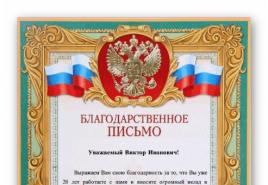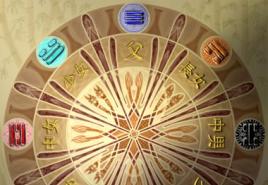Morse code alphabet in Russian. Morse code. a brief description of
It is necessary to study listening and transmission Morse code. The telegraph alphabet is formed from various combinations of short and long messages: dots and dashes. The duration of a dash corresponds to the duration of three dots, the interval between characters in one letter or number is equal to a dot.
The spacing between letters in a word is three dots. The interval between words is seven dots. Learning the telegraph alphabet is, although difficult, but quite accessible to everyone.
Learning Morse Code
One way to independently learn Morse code is using a computer. You can find many free programs on the Internet. For example, CW Code Practice Utility for DOS, CW Master, G4ILO morse generator, GenTexts, SUPER MORSE, Super Morse for Windows, LZ1FW Morse code trainer, Morse Cat, ARAK, Morse trainer, Morser, APAK-CWL, CW Beeper, ADKM and other.
When the telegraph has already been mastered, programs such as OXYGEN‘99 and Ultra High Speed CW Trainer have been written to increase speed. They can be freely downloaded from the Internet.
The table below shows chants for letters and numbers of the telegraph alphabet that are worth remembering. Each chant begins with the corresponding letter, syllables with the vowels “O” and “A” are sung protractedly, indicating a long premise (dash), and all others are sung briefly (dots).
Signs of the telegraph alphabet for letters of the Russian and Latin alphabets, numbers, punctuation marks and service marks are shown in Figures 1-2. Punctuation codes adopted in the Russian language, which differ from international codes, are shown in Figure 3.
Of course, this is just an example of tunes. You can use your own, as long as they associate you with the correct letters. You can record a couple of audio tapes with Morse code and listen to them at home yourself. Of course, in this case it will be more difficult to study the telegraph, but if you want, you can achieve everything.
Rice. 1. Signs of the telegraph alphabet for letters of the Russian and Latin alphabets, numbers, tunes.

Rice. 2. Signs of the telegraph alphabet for numbers, punctuation marks and service symbols, tunes.

Rice. 3. Punctuation codes adopted in the Russian language differ from international codes.
It’s easier to team up with a friend and study together the auditory reception and transmission of telegraphic signs using a key. But this can be done alone. At self-study telegraphic alphabet transmission by key and auditory reception are studied simultaneously. We remember the musical tune of each sign.
After mastering the signs of the telegraph alphabet, the speed of reception and transmission is increased. What is done gradually with systematic training.
There are always many service and amateur radio stations on the air at a slow speed. You can try to receive individual letters of a telegraph transmission from the air, although receiving from the air is more difficult than receiving from a sound generator or using computer programs.
A shortwave radio amateur needs knowledge of not only Russian, but Latin letters of the alphabet. When you master Morse code, then when working on the air via telegraph, make sure that this is a reliable and noise-resistant type of communication.
If you don’t have a computer, then to study the telegraph alphabet you need to have a telegraph key, a headphone and a simple sound generator.
Circuit of a simple sound generator
A simple sound generator circuit can be assembled using just two transistors, shown in Fig. 4. For ease of manufacture and repetition, a printed circuit board has been developed (Fig. 5. PCB size 32x28mm. Any germanium or silicon transistors with n-p-n conductivity will do.

Rice. 4. Circuit of an audio frequency generator for studying the telegraph, option 1.

Rice. 5. View of the printed circuit board of the audio frequency generator for studying the telegraph, option 1.
The diagram is shown in Fig. 6 has even fewer parts.

Rice. 6. Circuit of an audio frequency generator for studying the telegraph, option 2.
The circuit (Fig. 4) on transistors with n-p-n conductivity and the circuit (Fig. 6) can later be used as a tone call or for self-monitoring of the telegraph in the transceiver.
If transistors with p-n-p conductivity are used in the circuit (Fig. 4), then you need to change the polarity of the power source. In this version, the “plus” of the power supply will be connected to the emitters of transistors VT1, VT2. Printed circuit board remains the same.
Morse code is a special way of encoding various linguistic signs - letters, as well as numbers using two short ones - a dot, a long one - a dash. Morse code was originally used in the telegraph.
Morse code was invented by the American Samuel Morse in 1838. The idea to create a system came to Samuel after the publication of M. Faraday’s books, as well as Schilling’s experiments. Morse worked on his brainchild for more than three years until his work was crowned with success. The first signal was sent over a wire that was 1,700 feet long. The experiments interested Steve Weil, who financed Morse's experiments. It was thanks to him that the first related message was sent on May 27, 1844, the text of which was: “Wonderful are your works, Lord.”
Of course, over time the system has changed and improved. The final version was proposed in 1939. An interesting fact is that the code itself began to be called Morse code only with the beginning of the First World War. It was at that time that its “continental” version became widespread.

Like any sign system, Morse code has both advantages and disadvantages. Among the advantages of this code are the ability to record and reproduce signals using the simplest devices, the possibility of manual coding, as well as high immunity to interference provided that the message is received by ear even in the presence of strong radio interference.
As for the disadvantages, these include the low speed of telegraphy, the code itself is of little use for letter-printing reception, and besides, the transmission of one such sign requires an average of about 9-10 elementary messages, which is quite uneconomical.
The most famous signal transmitted by Morse code is SOS. This signal is allowed to be given only in situations where there is an imminent threat to the life of people or a vessel at sea. Despite the fact that many interpret the SOS signal as “Save our souls” or, according to some, “Save our ship”, this is absolutely not true. This type of signal was chosen only because of its simplicity: three dots, then three dashes and again three dots, which is quite easy to remember.

How to remember all the characters transmitted using Morse code? Tunes are one of the most famous and simple ways learn Morse code.
The chants are the rhythmic utterance of various sets of dashes and dots. It is worth noting that syllables containing vowels such as “a”, “y” or “o” indicate a dash, and the remaining syllables, as well as the sound “ai”, indicate a dot.
For example, the letter “i”, consisting of two dots, is learned by chanting the word “i-di”, and the letter “k” (-.-) - with the help of the phrase “kaaaak-zhe-taaak”.
Today, there are a lot of different programs with which you can learn Morse code, synthesize messages, encode and decode information using the alphabet, and also practice receiving and sending Morse signals using light.
Despite the fact that nowadays there are a lot of new systems and codes for transmitting information, Morse code is still popular among radio amateurs.
Morse code was developed in 1844 by Samuel F. B. Morse. More than 160 years have passed, and this type of message transmission is still used, especially by novice radio amateurs. Morse code can be transmitted quickly by telegraph and is also very convenient for transmitting a distress signal (SOS signal) using a radio, mirror or flashlight. Even people with limited communication abilities can use this method. But learning Morse code is not so easy - you have to try just as hard as when learning any new language.
Steps
- You can search for or buy recordings in Morse code, or use a shortwave transmitter and try to listen to them in live. There are educational computer programs that are usually not expensive or even free. They are more effective for training than notes, since they can be used to translate any text into Morse code, which will prevent you from memorizing one text and will help you choose the learning method that is right for you. Never count long and short signals - learn how each letter sounds. If you use the Farnsworth app, you can set the pause between letters to sound slower than the speed of the letter itself. Choose a letter speed slightly higher than what you are aiming for, and never slow it down—only shorten the pause between letters. Morse code is learned in this way - at a speed of 15-25 words per minute or more. The following methods are good when you are learning Morse code without expecting to use more than five words per minute, they will force you to discard the wrong ways of learning code and start again.
-
Find a copy of Morse code (like the one shown at the end of the page). You can use a basic table like the one shown on the right (click to enlarge) or you can use a more complex version that includes punctuation marks, abbreviations, expressions, and codes. Match what you hear with the letters of the alphabet. What word did you get? Were you right? Some people find it easier to learn Morse code by writing down dots and lines and then comparing them to a table as shown in the picture; others believe that this method only slows down the learning process. Do what pleases you best. If you choose a method that does not involve transcribing the recorded dots and lines, you can use a pronunciation table that contains the Morse code sounds the way you hear them.
Pronounce it. Practice the translation simple words and sentences in Morse code. At first you can write down the word, then sound it out, but over time you should try to pronounce the word right away. Here, for example, English word"cat". Write it down: -.-. .- - then say the word (you can use the buttons on mobile phone or voice over - this is the method that will most likely help you master Morse code faster). To pronounce Morse code, you must remember that dit is pronounced with a short "i" and a voiceless "t." Dah is a short sound. On English language the word “cat” is pronounced “dah-dee-dah-dee dee-dah dah.” Once you get the hang of it, choose a children's book and try to translate the text into Morse code, without writing down the letters. Record yourself and play back the recording afterwards to check how well you did.
- Don't forget about pauses. Each letter should be separated by pauses equal in length to the sound of a dash (i.e., three times longer than the sound of a dot). Each word must be surrounded by pauses, the length of the pauses is about 7 lengths of the sound of a period. The better you practice your pause placement, the easier it will be to understand your code.
-
Start by memorizing the simplest letters. If we talk about english alphabet, then the letter T is denoted as “-”, and the letter E is written as “.”. The letter M is written as “- -”, and I is written as “”. .”. Gradually move on to letters that require 3-4 dots or dashes in a row to write. Then start learning combinations of dots and lines, from simple to complex. Leave the most difficult combinations to learn last. Fortunately, these include the most rarely used letters (in English these are Q, Y, X, and V), so once you understand the structure of letters in Morse code, then focus on the most commonly used letters at the beginning. Please note that in english letters E and T have the shortest form, and the letters K, Z, Q, and X have the long form.
Create associations. For example, “p” - “pi-laa-poo-et, pi-laa-noo-et.” Considering that there is more than one alphabet in the world, and you are reading this article in Russian, then you are most likely interested in associations suitable for symbols of the Russian alphabet. For this reason, we do not provide options for the Latin alphabet in this paragraph. Instead, we encourage you to study the article, paying particular attention to the mnemonic form of each letter. There are mnemonic codes for remembering Morse code that were invented many years ago; you can buy them or find them online.
-
Enjoy learning. Want to get your friends to study? Teach them to blink in Morse code. And if, say, a friend takes you on an unsuccessful blind date, then you can blink “SOS” to him! Use Morse code to encrypt your secret notes, or keep a diary, or even tell dirty jokes without anyone but you and your friends getting it! Send someone a postcard with text in Morse code. Confess your love in Morse code (it's very romantic). In general, have fun, do what you like using Morse code - and you will learn it much faster.
- Download a Morse code app on your smartphone or download a tutorial - it can be very helpful!
- Practice! When is it issued to you? free time, ask a friend or family member to sit with you and listen to you translate the text into Morse code. Give them the table and ask them to decipher your messages. Not only will this help you and your assistant understand the code better, but it will also help you identify errors or bad habits that are preventing you from passing the code correctly, and correct them to prevent mislearning.
- To indicate that you made a mistake in passing the previous word, transmit 8 points. This will let the recipient of the signal know that the last word can be crossed out.
- Do not give up! Learning Morse code will not be easy; it's as difficult as learning any new language. It has unusual letters, abbreviations, grammatical styles and many other aspects that need to be learned. Don't get discouraged if you make mistakes, just keep practicing until you get it perfect.
- Listen very carefully. When you first start learning, listen to Morse code messages at a slow speed until you get used to it.
- Learning Morse Code Can Be Easy, if you use the right tools. Print and laminate the chart below and put it in your wallet. You will remember the code faster, since the sign will be at your fingertips all the time. Read the table from top to bottom. White is a dot, colored is a dash. Start with the Latin letters E and T, which are dots and dashes. As you go down, read each line. So V is “. . . -”. Good luck.
- You should not rely on the image, for you cannot train your ears with the help of sight. Don't learn using methods that slow you down, or you'll have to relearn when you need to learn to work faster. Your goal is to instantly recognize letters and then entire words, rather than counting dots and dashes. Computer programs like Koch and Farnesworth will help you with this.
Listen carefully to slow recordings of Morse code. You are essentially listening to long and short signals (lines and dots, respectively). Long signals sound 3 times longer than short ones. Each letter is separated from the others by a short pause, and the words from each other are longer (also 3 times).
List of Morse code characters
Morse code ("Morse code", "Morse code"), a list of signals consisting of a series of numbers, letters of the alphabet, punctuation marks and other symbols, which are a method of character encoding. The code itself consists of dots and dashes, reproduced using radio signals or interrupting a direct electrical current. Morse code got its name in honor of Samuel Finley Breeze Morse.
History of creation
Artist-inventor Samuel Morse

S. F. B. Morse.
Already in early childhood Samuel discovered a talent for drawing. Morse was inquisitive and always interested in science, enrolling in Yale University, 16-year-old Samuel Morse attended lectures on electricity that were popular at the time. Many years passed before interest turned to practical use knowledge. Known as an inventor, however, he also left his noticeable mark in art.
In 1832, setting sail from Le Havre to New York on a packet boat SALLY, he paid attention like a doctor Charles Thomas Jackson entertained the audience by demonstrating his magic trick experience. It was based on the use electromagnetic induction, the compass needle began to rotate as soon as a piece of wire was brought under electrical voltage. Morse had the idea that it would be possible to transmit certain signals through wires; during a month of sailing, he sketched preliminary drawings of the prototype of the telegraph.
Invention of the telegraph

Shapp's telegraph ABC.
The telegraph has existed since the 17th century; the optical telegraph by Claude Chappe was invented in 1792 and for a long time used in both the Old and New Worlds.
Pointer telegraphs and telegraphs with pointers were not particularly convenient. played a big role human factor, telegraph operator receiving station had to quickly read incoming signs and could not always check the accuracy of the transmitted message
Thanks to the help of a colleague from the chemistry department, Leonard Gale, the device showed the first signs of life. Electricity in the Morse apparatus was supplied by low-power galvanic batteries; the longer the wire between the transmitter and receiver, the more batteries were required. Morse, with the help of Gale, gradually increased the length of the wire to 300 meters.

The first Morse apparatus weighed 83.5 kilograms.
The device includes a lever on a spring; pressing it transmits an impulse. Depending on the duration of the press, the pulse was short or long. An electromagnet was used at the receiving end; one arm of the lever was attracted to its armature in accordance with the incoming impulses. A pencil was attached to the other shoulder as soon as it arrived electricity, the pencil lowered and left a mark on the moving paper tape in the form of a line. When the current supply stopped, the pencil rose, thus creating a gap.
In September 1837, Morse demonstrates his invention at New York University. New Jersey industrialist Steve Weil was in the audience. Interested in the innovation, he provided space for experiments and donated 2 thousand dollars, with the condition that Morse should take his son Alfred as an assistant. Alfred Weil had an engineering mind and made significant contributions to the creation of Morse code and the improvement of the transmitter.
Realizing the need to unite thousands of kilometers of the Atlantic coast with a single communication system (ordinary semaphores were not suitable for this role), in 1843 the government of the North American Republic awarded Morse a subsidy of 30 thousand dollars. A 65-kilometer line was built between Washington and Baltimore. On May 24, 1844, the first telegram was sent over this line with the words “Wonderful are your works, Lord!”

Morse demonstrates his invention to scientists.
In 1858, Charles Wheatstone creates an automatic telegraph machine using punched paper tape. The operator, using Morse code, typed messages into a puncher, and the transmission was carried out by feeding the tape into the telegraph. In this way, it was possible to transmit up to 500 letters per minute, which is five to six times more than with manual work using a key. At the receiving station, the recorder typed a message onto another paper tape.
Subsequently, the recorder was replaced by a signaling device that converted dots and dashes into long and short sounds. Operators listened to the messages and recorded their translations.
The Morse telegraph was used not only in the 19th century, but also in the 20th century. In 1913, the Russian telegraph network consisted of 90% Morse machines.
Morse code

Morse telegraph.
The invented device could not display letters, only lines of a certain length. Therefore, each alphabet character and number was assigned its own combination, consisting of combinations of short and long signals, which were depicted on a paper tape.
The original Morse code table is different from the one used today. It used characters of not two, but three different durations (dot, dash and em dash). Rarely encountered letters and numbers included combinations of three to five characters; some characters had pauses within their codes. Due to the large number of signs, confusion was created, which significantly complicated the work of receiving telegrams.
Spreading throughout the world, the alphabet has gone through a lot of transformations. In the Russian language, Latin letters were replaced by Cyrillic letters consonant with them. The Japanese, with their hieroglyphic writing, invented their own version of Morse code; in the so-called “Wabun code,” each combination of dots and dashes denoted not a separate letter, but an entire syllable.
The code was gradually refined; the encodings of the modern and original tables coincide for about half of the letters and do not coincide for a single digit. In the current Morse code, each letter corresponds to a combination of long units (dashes) and short units (dots). The pause between characters in a letter is one dot, and between letters in a word there are 3 dots, the pause between words is 7 dots.
In practice, memorizing the combination of dots and dashes for each letter is possible at low baud rates, but as the speed increases, errors are likely to occur. To seriously study the code, you need to remember not the number of dots and dashes in a letter, but the “chant” that is produced when the entire letter sounds. Thus, when you hear the chant "Gaa-gaa-rin", it means the letter "G" has been rendered. “Chants” may vary depending on the school of study. If the radiogram contains only numbers, then instead of five dashes only one dash is transmitted. For the most popular phrases and letters in everyday life, simplified combinations of letters or numbers have been developed.
Although nowadays it is common to use modern methods Communications, thanks to its simplicity and reliability, professionals and amateurs use Morse code in radio communications even today.
Using Morse Code
When traveling long distances, the signal can be distorted and interfered with; a signal transmitted by Morse code is easier to recognize and save. Encoding can be done manually; signals are recorded and played back using simple devices. As a simple and reliable coding system, Morse code is used in almost all areas where CW communications are used.
Thanks to the presence of a short-wave radio transmitter with Morse code transmission, in difficult situations it is possible to transmit information to rescue services and the information will reach the scene of the disaster.
Morse code was widely used in military radio communications. In the Navy through signal spotlights, Morse code is used in visual communication between ships in line of sight in conditions of radio silence. Lighthouses and buoys use signal lights to transmit certain letter combinations in Morse code, and these combinations are given in
It happens that children read books about scouts or watch enough films about brave sailors and ask dad or mom to teach them Morse code. And parents are faced with the question of how to learn Morse code on their own and then teach it to their child.

To quickly teach a child Morse code, you need two things - constant training and a systematic approach. Systems approach is that you need to choose one way or another of learning. For example, you can install a computer program that will quickly and easily teach your child to encode a particular message. In this case, the Morse Code program and Morse Code Trainer are suitable for you.
You can use the educational tablet for training. It will not only contain a verbal designation for each Morse code character. You can also find different combinations of dashes and dots that create syllables. It will also be easy to remember such an alphabet due to associations. For example, the letter “D” is associated with the word “houses”. The syllabic designation of this Morse sign looks like “doo-mi-ki.” If you translate this into Morse code, you get the following combination “taa-ti-ti”, where “ta” represents an em dash and “ti” represents a short period.
Well, the last option is to study Morse code with your child using the alphabet. This will not be a simple alphabet; in it, each letter drawn in Morse code will follow the contour of each corresponding letter. This alphabet is easier to learn by looking at each image. You can ask your child to sketch each letter, then try to reproduce the alphabet from memory.
Morse code
Semi-automatic telegraph key

The first semi-automatic telegraph keys appeared in the 19th century. But modern electronic semi-automatic keys appeared in the mid-20th century. Such a key consists of a switch that has two contacts. They are washed when the handle is slightly tilted to the right or left from the neutral position.
The electronic unit provides sequences of short or long bursts of a given duration in the output circuit when the right or left contacts of the manipulator are closed, respectively. The basis of the block is usually a square-wave clock generator and a simple logic circuit.
How to make a telegraph
Of course, a child can ask a parent how to make a telegraph on their own. Of course, this is not a matter of five minutes. To quickly create a house code yourself and encode symbols and numbers so that only dots and dashes are displayed on paper.
You can make the simplest telegraph yourself, but for this you will need to have:
- Series connected coin cell batteries.
- Bell transformer.
- Call button.
- Magneto.
- Antenna.
Assembling such a telegraph is certainly not a matter of five minutes, but if you try, you can create a simple but working tool to continue learning. So, what steps need to be taken to assemble a telegraph:
- Attach the transformer from the bell and magneto to the board with the base; it should be made of pieces copper wire, which is wound on two studs.
- Attach the batteries and the bell button to the stand. Attach a thin sheet antenna to the board.
- You need to connect the positive pole of the battery through a transformer to the magneto. If everything is working correctly, then a spark should jump between the magneto tips.
- The receiver must consist of a battery, a light bulb, a switch, an antenna and a coherer.
- Attach the coherer to the board on the stand. It can be made from a piece of glass tube approximately 3 cm long with a diameter of 0.5 cm, filled with iron and silver filings (in a ratio of 2:1). The tube must be sealed on both sides with rubber stoppers, and needles must be pierced into them so that their points in the sawdust are at a distance of about 3 mm from each other.
- Place the light bulb in the socket and the battery there. Secure the switch and install the antenna.
- Place both devices opposite each other. You can start using it.
Morse telegraph
Learning to read by syllables
To easily and quickly learn to read Morse code, syllable by syllable, consisting of dashes and dots, you will first have to start spending a few minutes a day memorizing Morse code symbols by ear, and also have a visual perception in front of you. It is best to print out a sign with dashes and dots and carry it with you. It is advisable to repeat what is written on the sign not only to yourself, but also to say it out loud.
Listen to your friends and very simple text Morse code by ear for at least a couple of minutes a day and very soon you will begin to recognize where the dashes are and where the dots are, and you will also be able to immediately perceive whole words. Try to choose very easy texts that suit your level, then there will be no problems with studying.
Key manipulator
The designs of key manipulators are very different. The handle can be single, it can be shared between two contacts, or it can be double, consisting of two halves, which are arranged in parallel so that each makes its own contact. To code well, the single handle can be awkward. This happens because the handle may accidentally deflect during operation and close the second contact.
The most primitive version of the manipulator is an elastic plate, which at one end is attached to a vertical base, and the other end has a flat handle and a pair of contacts on both sides. There should be no play on the manipulator, there should be good contact and easy working movement.
How to increase your reception speed
When you have already learned the alphabet and know all the symbols, then perhaps it is time to learn to accept texts that have standard pauses between dashes and periods. You will need to learn to accept about 50-60 characters in a short time, say, in a few minutes. Of course, you can first slightly reduce the reception speed and write the code more slowly and with errors. Gradually, over a few minutes, you will be able to accept more characters and the code will no longer contain errors.
In order to practice receiving radio communications and its code, as well as learn how to translate received information, you will need to learn how to write the dash and dot symbols sign by sign, while never lifting your pen from the paper. If you were unable to immediately write down one or another character that is included in the code, skip it immediately without making any delays. You will be able to identify the sign later, as long as you don't miss the following signs.

If you realize that within a few minutes of acceptance, your code receives the same errors that are repeated over and over again, you need to learn to accept only those characters, numbers or words with which problems arise. This training allows you to learn to recognize symbols and reduce the number of errors.
When accepting a large code in a few minutes, try not to achieve a perfect acceptance. If in a few minutes the percentage of errors is no more than five, then you will have to continue training and increase your speed.
To learn how to accept a code and translate it in a few minutes, easily deciphering where the dot is and where the dash is, you can listen to already familiar texts at high speed and at the same time deciphering dots and dashes from the printout.
Any few minutes of training while you accept the code should be varied. Change the speed, tone, content of texts. Make high-speed bursts by accepting small texts at high speed.
Learning Morse code







